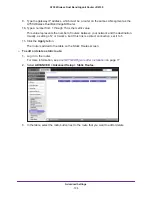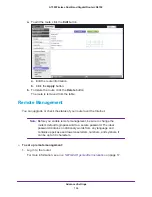
Advanced Settings
122
A750 Wireless Dual Band Gigabit Router JR6150
How Port Forwarding Differs from Port Triggering
The following points summarize the differences between port forwarding and port triggering:
•
Any computer on your network can use port triggering, although only one computer can
use it at a time.
•
Port forwarding is configured for a single computer on your network.
•
Port triggering does not require that you know the computer’s IP address in advance. The
IP address is captured automatically.
•
Port forwarding requires that you specify the computer’s IP address during configuration,
and the IP address can never change.
•
Port triggering requires specific outbound traffic to open the inbound ports, and the
triggered ports are closed after a period of no activity.
•
Port forwarding is always active and does not need to be triggered.
Set Up Port Forwarding to Local Servers
You can configure the router to forward specific incoming protocols to computers on your
local network. For example, you might want to make a local web server, FTP server, or game
server visible and available to the Internet. In addition to servers for specific applications, you
can also specify a default DMZ server to which all other incoming protocols are forwarded.
Before starting, you must determine which type of service, application, or game you want to
provide, and the local IP address of the computer that should provide the service. The server
computer must always have the same IP address.
Tip:
To ensure that your server computer always has the same IP address,
use the reserved IP address feature (see
Address Reservation
on
page
50) of your router.
To set up port forwarding:
1.
Log in to the router.
For more information, see
Use NETGEAR genie after Installation
on page
17.






























